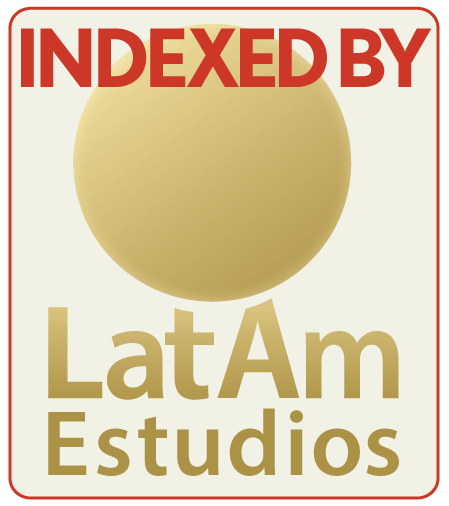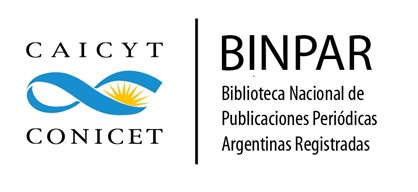Tan lejos, tan cerca
Algunos ejemplos del uso del espacio femenino en la literatura inglesa medieval
DOI:
https://doi.org/10.24215/23139048e056Palabras clave:
espacio, género, Ancrene Wisse, El libro de Margery KempeResumen
Dentro de los estudios medievales, la cuestión del espacio en su relación con el género ha sido bien estudiada. Dentro de esa tradición, se analizan aquí dos textos ingleses: Ancrene Wisse, un manual de conducta escrito para tres reclusas de Herefordshire en el siglo XIII; y El libro de Margery Kempe, la autobiografía de una mujer devota procedente de King’s Lynn a principios del siglo XV. Ambas obras demuestran la relevancia de esta relación así como la complementariedad existente en el tiempo entre estas figuras femeninas dentro del paisaje religioso bajomedieval.
Descargas
Citas
Aelred de Rievaulx (1971). Aelredi Rievallensis. Opera omnia I: Opera Ascetica (Ed. A. Hoste y C. H. Talbot). Turnhout, Bélgica: Brepols.
Ancrene Wisse. Guide for Anchoresses (2009). (Trad. Bella Millett). Exeter, Reino Unido: U of Exeter P.
Aston, M. (1984). Lollards and Reformers: Images and Literacy in Late Medieval Religion. Londres, Reino Unido: Hambledon.
Auerbach, E. (1965). Literary Language and Its Public in Late Latin Antiquity and in the Middle Ages. Londres, Reino Unido: Routledge.
Beda (1969). Ecclesiastical History of the English People (Ed. B. Colgrave y R. A. B. Mynors). Oxford, Reino Unido: Oxford UP.
Bloch, H. (1991). Medieval Misogyny and the Invention of Romantic Love. Chicago, United States: U of Chicago P.
Bond, J. (2003). English Medieval Nunneries: Buildings, Precincts, and Estates. En D. Wood (Ed.), Women and Religion in Medieval England (pp. 46-90). Oxford, Reino Unido: Oxbow Books.
Brown, P. (1982). Society and the Holy in Late Antiquity. Binhamton, United States: Faber and Faber.
Brown, P. (1988). The Body and Society. Men, Women, and Sexual Renunciation in Early Christianity. Nueva York, United States: Columbia UP.
Cannon, C. (2003). Enclosure. En C. Dinshaw y D. Wallace (Eds.), The Cambridge Companion to Medieval Women’s Writing (pp. 109-23). Cambridge, Reino Unido: Cambridge UP.
Chitty, D. J. (1999). The Desert a City. Oxford, Reino Unido: Blackwell.
Clay, R. (1953). Further studies on medieval recluses. The Journal of the British Archaeological Association, serie 3ª (16), 74-86.
Dobson, E. J. (1976). The Origins of Ancrene Wisse. Londres, Reino Unido: Oxford UP.
Finke, L. (1992). Feminist Theory, Women’s Writing. Ithaca, United States: Cornell UP.
Georgianna, L. (1981). The Solitary Self. Individuality in the Ancrene Wisse. Cambridge, United States: Harvard UP.
Gilchrist, R. (1994). Gender and Material Culture: The Archaeology of Religious Women. Londres, Reino Unido: Routledge.
Giner Sempere, S. (1954). La mujer y la potestad de orden: incapacidad de la mujer. Argumentación histórica. Revista española de derecho canónico, (9), 841-69.
Grayson, J. (1974). Structure and Imagery in Ancrene Wisse. Hanover, United States: U of New Hampshire.
Green, D. H. (2007). Women Readers in the Middle Ages. Cambridge, Reino Unido: Cambridge UP.
Hanawalt, B. (1998). ‘Of Good and Ill Repute’. Gender and Social Control in Medieval England. Mineápolis, United States: U of Minnesota P.
Herbert McAvoy, L. y Hughes-Edwards M. (2005). Anchorites, Wombs and Tombs. Intersections of Gender and Enclosure in the Middle Ages. Cardiff, Reino Unido: U of Wales P.
Horner, S. (2001). The Discourse of Enclosure. Nueva York, United States: State U of New York P.
Jäggi, C. y Lobbedey, U. (2008). Church and Cloister: The Architecture of Female Monasticism in the Middle Ages. En J. F. Hamburger y S. Marti (Eds.), Crown & Veil: Female Monasticism from the Fifth to the Fifteenth Centuries (pp. 109-31). Nueva York, United States: Columbia UP.
Jones, E. A. (Ann. & Trad.) (2019). Hermits and Anchorites in England, 1200-1550. Manchester, Reino Unido: Manchester UP.
Kempe, M. (2000). The Book of Margery Kempe (Ed. B. Windeatt). Edinburgh Gate, Reino Unido: Longman Annotated Texts.
Klapisch-Zuber, C. (Ed.) (1992). Historia de las mujeres, La Edad Media, vol. II. Madrid, España: Taurus.
Licence, T. (2011). Hermits and Recluses in English Society. 950-1200. Oxford, Reino Unido: Oxford UP.
Lochrie, K. (1999). Covert Operations. The Medieval Uses of Secrecy. University Park, United States: U of Pennsylvania P.
Lochrie, K. (2003). Between Women. En C. Dinshaw y D. Wallace (Eds.), The Cambridge Companion to Medieval Women’s Writing (pp. 70-90). Cambridge, Reino Unido: Cambridge UP.
Macy, G. (2008). The Hidden History of Women’s Ordination. Female Clergy in the Medieval West. Oxford, Reino Unido: Oxford UP.
Makowski, E. (1997). Canon Law and Cloistered Women. Periculoso and Its Commentators, 1298-1545. Washington, United States: The Catholic U of America P.
McNamara, J. A. (1993). The Rhetoric of Orthodoxy: Clerical Authority and Female Innovation in the Struggle with Heresy. En U. Wiethaus (Ed.), Maps of Flesh and Light. The Religious Experience of Medieval Women Mystics (pp. 9-27). Syracusa, United States: Syracuse UP.
McNamara, J. A. (1996). Sisters in Arms. Catholic Nuns through Two Millennia. Cambridge, United States: Harvard UP.
Morin, J. (1969). Commentarius de sacris ecclesiae ordinationibus secundum antiquos et recentiores latinos, graecos, syrios et babylonios in tres partes distinctus. 1695; reprint. Farnborough, Reino Unido: Gregg.
Newman, B. (1995). From Virile Woman to Woman Christ: Studies in Medieval Religion and Literature. University Park, United States: U of Pennsylvania P.
Nicholson, J. (1978). Feminae Gloriosae: Women in the Age of Bede. En D. Baker (Ed.), Medieval Women (pp. 15-29). Oxford, Reino Unido: Blackwell.
Pien, J. (1746). Tractatus Praeliminaris De Ecclesiae Diaconisssis. En J. Bollandus et al. (Eds.), Acta Sanctorum, eds. Amberes, Holanda: Bernard Albert Vander Plassch.
Power, E. (1922). Medieval English Nunneries. Cambridge, Reino Unido: Cambridge UP.
Robertson, E. (1990a). An Anchorhold of Her Own: Female Anchoritic literature in thirteenth century England. En J. Bolton Holloway, C. S. Wright y J. Bechtold (Eds.), Equally in God’s Image: Women in the Middle Ages (pp. 170-183). Nueva York, United States: Peter Lang.
Robertson, E. (1990b). Early English Devotional Prose and the Female Audience. Knoxville, United States: The U of Tennessee P.
Salisbury, J. E. (1991). Church Fathers, Independent Virgins. Londres, Reino Unido: Verso.
Smith, L. (1997). Scriba, Femina: Medieval Depictions of Women Writing. En J. H. M. Taylor y L. Smith (Eds.), Women and the Book. Assessing the Visual Evidence (pp. 21-45). Toronto, Canadá: The British Library y The U of Toronto P.
Spacks, P. M. (1985). Gossip. Chicago, United States: U of Chicago P.
Tolkien, J. R. R. (1962). The English Text of the Ancrene Riwle: Ancrene Wisse: Edited from MS Corpus Christi College Cambridge 402. EETS. Londres, Reino Unido: Oxford UP.
Wada, Y. (2003). A Companion to the Ancrene Wisse. Cambridge, Reino Unido: D. S. Brewer.
Warren, A. K. (1985). Anchorites and Their Patrons in Medieval England. Berkeley, United States: U of California P.
Webb, D. (2007). Privacy and Solitude in the Middle Ages. Humbledon Continuum.
Wogan-Browne, J. (2001). Saints’s Lives & Women’s Literary Culture. Virginity and Its Authorizations. Oxford, Reino Unido: Oxford UP.
Publicado
Cómo citar
Número
Sección
Licencia
Derechos de autor 2022 Cuadernos de H ideas

Esta obra está bajo una licencia internacional Creative Commons Atribución-NoComercial-CompartirIgual 4.0.
La aceptación de un original por parte de la revista implica la cesión no exclusiva de los derechos patrimoniales de los/as autores/as en favor del editor, quien permite la reutilización, luego de su edición (postprint), bajo una Licencia Creative Commons Atribución-NoComercial-CompartirIgual 4.0 Internacional (CC BY-NC-SA 4.0)
Acorde a estos términos, el material se puede compartir (copiar y redistribuir en cualquier medio o formato) y adaptar (remezclar, transformar y crear a partir del material otra obra), siempre que a) se cite la autoría y la fuente original de su publicación (revista y URL de la obra), b) no se use para fines comerciales y c) se mantengan los mismos términos de la licencia.
La cesión de derechos no exclusivos implica que luego de su edición (postprint) en Cuadernos de H ideas las/os autoras/es pueden publicar su trabajo en cualquier idioma, medio y formato; en tales casos, se solicita que se consigne que el material fue publicado originalmente en esta revista.
Tal cesión supone, también, la autorización de los/as autores/as para que el trabajo sea cosechado por SEDICI, el repositorio institucional de la Universidad Nacional de La Plata, y sea difundido en las bases de datos que el equipo editorial considere adecuadas para incrementar la visibilidad de la publicación y de sus autores/as.
Asimismo, la revista incentiva a las/os autoras/es para que luego de su publicación en Cuadernos de H ideas depositen sus producciones en otros repositorios institucionales y temáticos, bajo el principio de que ofrecer a la sociedad la producción científica y académica sin restricciones contribuye a un mayor intercambio del conocimiento global.










.png)



























